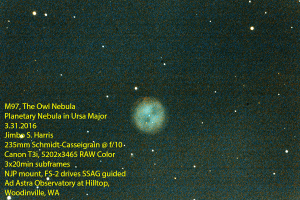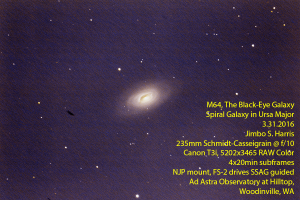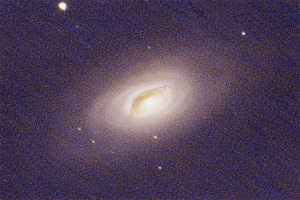Thus begins a new era.
First, a little history.
When I built the observatory in Newark, CA, the light pollution was so bad that the sky never got darker than about brownish-pink — there was a shopping mall nearby, and an interstate, and about a million other humans. For me, this meant that when doing deep-sky photography, the skyglow started dominating the signal (and the noise, for that matter) in any image longer than about 5min. I could use narrowband filters to get around this problem, and I had a grand time, shooting 20m H-alpha subframes during Nebula Season.
But springtime is Galaxy Season, and galaxies are pretty much the definition of “wide band” targets, emitting photons at every wavelength from deep in the radio to deep in the X-ray, and sometimes beyond (on both ends of the scale). So, narrowband filters don’t work well. I shot some Ha of a galaxy once, just to see what I was up against, not worth the effort.
So anyway, what with one thing and another, I kind of have “5min subframes” in my head as “the default”. For all but the brightest objects, 5min is quite short, but there you go.
As I’ve said before, the skies here are much darker, and they hold up well under 20min subframes, even full-spectrum ones.
So today, not for the first time, but from now on, I decided to use 20min subframes as “the default”, and we’ll see what happens.
My first target of the evening was M97, The Owl Nebula, which I’d also tried to shoot last night, but this time, I took an hour of 20m shots instead of a bunch of fives, and… well, it’s still pretty noisy. Three frames in the stack doesn’t leave a lot of signal-to-noise averaging, and The Owl is primarily Oxygen, which glows green, which gets a lot less signal than the red channel in my modded DSLR. Note to self: learn how to white-balance a modded DSLR. It’s been 11 years, figure it out.

This target deserves more love from me. Now that I seem to have a rig that can capture itty bitty stuff, I will see if I can do better.
Oh, might as well mention that I had my reservations about whether Cassie would perform as a DSO scope; f/10 is daunting, and the huge 2350mm focal length produces 0.4″/px on the T3i camera (note: the local seeing is usually 1″-2″, so everything will get randomly smeared over 4-10 pixels; yay), meaning that autoguiding will be tougher, too. But, since I usually resize the 5184×3456 image down to 900×600 anyway, I figure what’s a few sloppy pixels between friends?
In short, I’m happy with the scope so far. I have not really put it through its automation paces, so I’m sure that mirror flop and lots of other gremlins are still waiting for me. So far, so good.
I have also been quite pleased with the NJP / FS-2 performance. Even with sketchy initial alignment stars, GOTO has been putting targets into the 35’x23′ FOV of the camera (that’s too small to get the whole full moon into), every time.
But, I digress.
Once The Owl got too high, I decided to switch to another of the pretty galaxies that live up near Ursa Major. This one is M64, The Black-Eye Galaxy, which has a very interesting dust lane that looks like the poor thing has a shiner.

Here’s a closer look at the galaxy, in my usual 1500×1000 -> 900×600 “full crop” fashion.

This was the fourth night in a row of astronomizing — what a nice run, just after the Spring Equinox.

MOST COMMENTED
Observatory
Observatory 2.0 – Time has come today!
General / Maintenance
First Light, a deeper look
Mount / Observatory / Telescope
Observatory 2.0 – Result!
Observatory
Observatory 2.0 – The Pier goes in
Gear / General / Maintenance
Martin Farmer Wormblock installation notes
Deep Sky / Long Exposure Photography
NGC2244, The Rosette Nebula
Deep Sky / Long Exposure Photography
Another beautiful night.